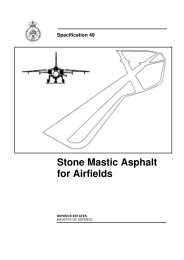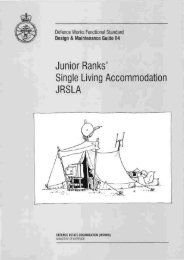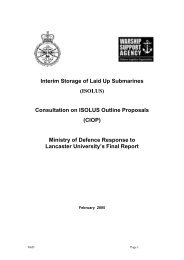Part III - Historical Survey of the Porton Down Service Volunteer ...
Part III - Historical Survey of the Porton Down Service Volunteer ...
Part III - Historical Survey of the Porton Down Service Volunteer ...
Create successful ePaper yourself
Turn your PDF publications into a flip-book with our unique Google optimized e-Paper software.
staff member and moved to sampling positions. <strong>Volunteer</strong>s stood in a line, 5 yards apart, and<br />
remained <strong>the</strong>re until <strong>the</strong> cloud generated by <strong>the</strong> shell had passed over <strong>the</strong>m. The distance<br />
from <strong>the</strong> sampling positions to <strong>the</strong> point at which <strong>the</strong> shell was burst was chosen, based on<br />
measurements <strong>of</strong> temperature and wind speed, so that <strong>the</strong> maximum accumulated exposure<br />
experienced by volunteers would not exceed 12 mg.min/m 3 .<br />
Trial 1. Ten volunteers took part. Three shells were exploded one at a time: one<br />
shell with GB stabilised with triethylamine, one with GB alone, and one with water.<br />
GB (from <strong>the</strong> first two shells) at <strong>the</strong> sampling points varied from 0.35 - 1.6 mg.min/m 3 .<br />
Trial 2. Eight volunteers took part. Four shells were exploded one at a time: three<br />
had <strong>the</strong> same fillings as Trial 1, <strong>the</strong> fourth contained GB stabilised with ammonia. GB<br />
at seven <strong>of</strong> <strong>the</strong> sampling points varied from less than 0.35 mg.min/m 3 to<br />
1.4 mg.min/m 3 . The volunteer at <strong>the</strong> remaining sampling position was exposed to<br />
10.5 mg.min/m 3 .<br />
The volunteers who participated in <strong>the</strong> trials were able to distinguish by smell <strong>the</strong> shells<br />
containing GB from those containing water. The stabilisers seemed to make <strong>the</strong> smell<br />
appreciably stronger. Ano<strong>the</strong>r set <strong>of</strong> field trials was conducted in February 1952 [38] and <strong>the</strong><br />
procedure adopted in <strong>the</strong> December 1951 field trials was used again. Four trials were carried<br />
out, with a wider variety <strong>of</strong> stabilisers.<br />
Trial 1. Twelve volunteers took part. Four shells were used: one with water, one<br />
with GB alone, one with GB stabilised by triethylamine and one with GB stabilised by<br />
diethylamine. The exposure levels in this trial were 0.4 - 1 mg.min/m 3 .<br />
Trial 2. Ten volunteers participated. Four shells with <strong>the</strong> same fillings as Trial 1<br />
were used. Exposure levels were 0.4 - 1.7 mg.min/m 3 .<br />
Trial 3. Fifteen volunteers participated. Three shells were used, one with water, one<br />
with GB alone and one with GB stabilised by methyl-N-morpholine. Exposures were<br />
0.4 - 1.1 mg.min/m 3 .<br />
Trial 4. Fifteen volunteers took part. Three shells with <strong>the</strong> same filling as Trial 3<br />
were used. Exposure levels were 0.5 - 3.2 mg.min/m 3 .<br />
As in <strong>the</strong> December trials, volunteers were able to detect GB by smell. The volunteers found<br />
little difference between <strong>the</strong> smell <strong>of</strong> GB alone and <strong>of</strong> stabilised GB. This was thought by<br />
<strong>Porton</strong> to be somewhat suspicious as it "suggested <strong>the</strong> possibility <strong>of</strong> collusion having<br />
occurred between observers" [39]. Therefore a fur<strong>the</strong>r set <strong>of</strong> trials was carried out March<br />
1952 but in this trial each volunteer was accompanied at his sampling point by a "responsible<br />
scientist", thus eliminating <strong>the</strong> possibility <strong>of</strong> collusion. Apart from this pairing arrangement,<br />
<strong>the</strong> procedure adopted for <strong>the</strong> trials was <strong>the</strong> same as before.<br />
• Two shells were used: one with GB alone and one with GB stabilised by<br />
triethylamine.<br />
• Nineteen sampling positions were used. At 18 <strong>of</strong> <strong>the</strong>m a volunteer was<br />
accompanied by a member <strong>of</strong> <strong>Porton</strong> staff. At <strong>the</strong> nineteenth, two volunteers and<br />
one member <strong>of</strong> staff were used. Exposures experienced were 0.4 - 1.7<br />
mg.min/m 3 .<br />
No significant difference was found between <strong>the</strong> smell <strong>of</strong> GB alone and stabilised GB. The<br />
trial confirmed that GB dispersed explosively by a shell could be detected by smell at<br />
concentrations <strong>of</strong> 0.5 - 0.8 mg/m 3 [39]. Trials were held later in March to find out if GB<br />
dispersed as a spray, ra<strong>the</strong>r than in an explosion, could be smelled [40]. Ten volunteers<br />
participated. GB alone and stabilised GB were released as spray individually. The duration<br />
<strong>of</strong> each exposure was about 50 seconds and <strong>the</strong> levels varied from 0.4 to 3.1 mg.min/m 3 .<br />
<strong>Volunteer</strong>s were unable to detect any difference in smell between <strong>the</strong> two sprays. However,<br />
64









